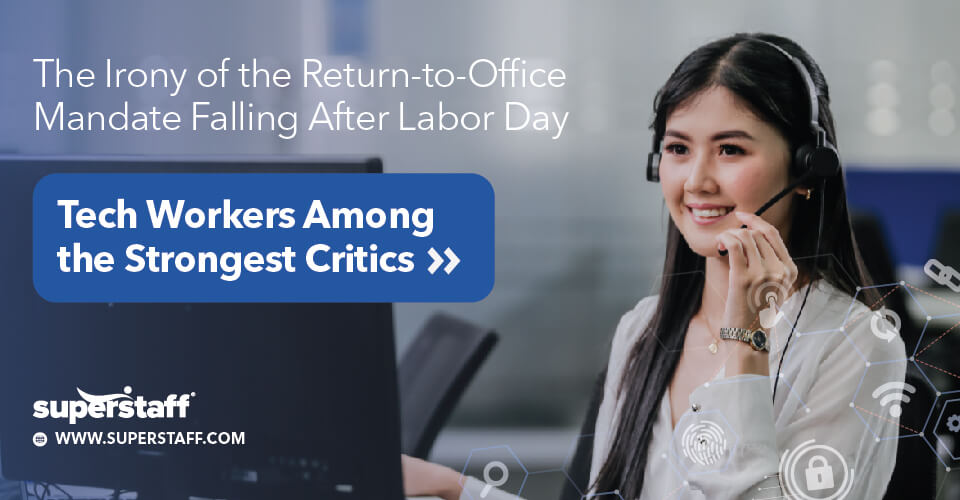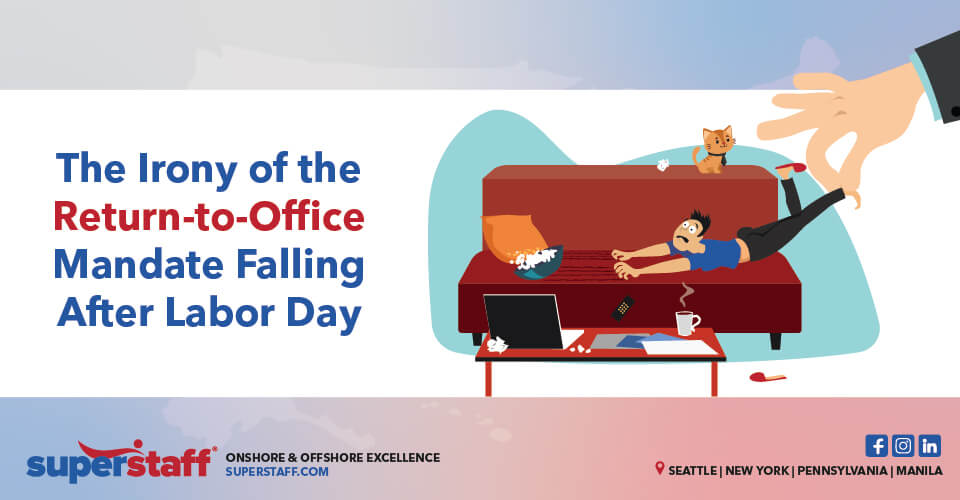
Every first Monday of September, people from all walks of life celebrate Labor Day. This federal holiday honors the hard work and contributions of workers to the development and growth of the United States, as well as recognizing the country’s history of organized labor movements and trade unions.
This year, however, in an ironic twist of fate, an ongoing and controversial labor issue falls on the same month meant to celebrate labor movements: the return-to-office mandate.
When the COVID-19 crisis began slowing down, businesses were eager to revert to the pre-pandemic workplace dynamic, with many requiring employees to return to the office as soon as possible. However, workers received these RTO mandates with fierce resistance. Strong objections came from the tech employees who argued they are as productive offsite where they can skip stress from commuting and food and gas price hikes.
This article will delve deeper into the latest news and headlines surrounding the ongoing return-to-office debate to help you understand the discussion. Let’s take a closer look!
Tech Workers Are Pushing Back Against the Return-to-Office Mandate

Apple
In March 2022, after two years of working from home, Apple announced its plan to bring workers back to the office by April of the same year. The tech giant had previously delayed its return-to-office mandate several times because of the fluctuations in COVID-19 cases.
In response to the company’s April return-to-office deadline, workers formed an internal advocacy movement called Apple Together. The group released an open letter and petition urging Apple leaders to reconsider their policy and implement flexible work arrangements.
The movement was fruitful because Apple ended up allowing employees to continue working from home “for the time being.” From May to July, the company’s leaders did not set a new date for the resumption of the initial mandate.
However, in August 2022, Apple seemed to call workers back to the office again, setting a new deadline on September 5. Employees will be required to work onsite thrice a week by that date.
The Apple Together movement has launched a new petition against the September mandate, collecting signatures calling for location-flexible work. In addition, one high-ranking Apple employee, Ian Goodfellow, the director of machine learning, resigned because of the company’s stance on remote work.
Time will tell whether Apple’s latest return-to-office mandate will be enough to bring workers back onsite for good or cause further discord between the company and its employees.
Read More: Top 5 Controversies Surrounding Return-to-Office Mandate
AT&T
Much like the rest of the world, AT&T, one of the world’s largest telecommunications companies, was compelled to adopt remote work arrangements at the height of the global pandemic. Although the company initially agreed to continue allowing employees to work from home, reports say that many workers are being required to work onsite.
Through their union, Communications Workers of America (CWA), AT&T employees are fighting back against the return-to-office mandate. The group is striking a deal with the telecom giant, urging them to extend the work-from-home policy through March 2023.
Tesla
In June 2022, Tesla founder Elon Musk made headlines for issuing a strict ultimatum to his workers: either work onsite for at least 40 hours a week or resign. His stance against remote work arrangements proved controversial, garnering employee pushback and sparking outrage among social media users.
Despite strong resistance, Tesla is pushing through with Musk’s return-to-office mandate. The electric car manufacturing company has been tracking its employees’ ID badge swipes and sending warning emails to those who have been in the office for less than 40 hours.
Affected Tesla workers have voiced frustration with the “controlling and out-of-touch” attendance tracking system. In a recent poll from the tech jobs site Blind, nearly 70% of respondents believe that Tesla will face a spike in resignations due to the return-to-office ultimatum.
In addition to having many vocally unhappy workers, crowded offices are another problem Tesla currently faces amid Musk’s strict return-to-office policy. At their corporate site in Fremont, employees have reported not having enough desks and parking areas to accommodate everyone. They also experienced problems with slow Wi-Fi because of the large number of people coming into the office to work.
Labor Day Showdown: The Return-to-Office Debate Continues in September
Tech workers may be leading the charge when protesting return-to-office policies. Still, companies of all sectors face similarly fierce resistance from their employees. Peloton Interactive Inc., JPMorgan Chase, Royal Bank of Canada, and Comcast are just a few companies returning to the office in September.
Experts predict that this year’s Labor Day will intensify the push and pull between business leaders and workers. For now, companies want to transition to hybrid work schedules instead of demanding that employees come to the office daily, but many people are sticking to their fully WFH preference.
American Workers Are in the Driver’s Seat
The RTO debate is pushing many employees to resign from their jobs and seek roles with permanent work-from-home setups. Some have even left the corporate world entirely and chose to become freelancers. One study found that 73% of workers turned to freelance because it allowed them to work remotely and control their schedule.
Since U.S. employees have been pushing back so strongly against return-to-office mandates, even president Joe Biden felt the need to issue a statement encouraging workers to embrace onsite work. In early March, Biden reiterated that Americans should feel safe returning to the office because the country has made significant progress fighting COVID-19.
Amid Return-to-Office Debates, US Companies Are Seeking Tech Talents in the Philippines
The recent Upwork Future Workforce Report found that 69% of hiring managers plan to hire more employees within the next few months. However, 60% also say they are having difficulty finding qualified talents.
As conversations surrounding return-to-office policies become heated, what can tech companies do to grow their operations and strengthen their workforce? For many businesses, the ideal solution can be outsourcing to the Philippines.
In March 2022, the Philippine government mandated that workers return to the office by September, and most BPOs (including tech outsourcing professionals) are complying. Tech startups see the country as an ideal outsourcing location because of its surplus of educated young workers with niche or high-end skills in data analytics, mobile app and software development, and financial analysis.
The Philippines is home to premier universities producing over 130,000 IT and engineering graduates yearly. Many U.S. companies have been finding success by tapping into this massive talent pool.
Expand and Optimize Your Workforce Through Tech Outsourcing
Today’s business leaders face the unenviable task of navigating the constantly evolving post-pandemic workplace dynamic. Tech companies, in particular, are struggling to meet growing consumer demand while balancing employees’ needs and preferences.
SuperStaff provides scalable tech outsourcing services that enable businesses to adapt to changing market conditions. Whether embracing remote work or opting for return-to-office policies, our team can provide the custom solution your business needs to thrive.
Contact us today, and let our experienced tech outsourcing professionals help you optimize your capabilities!






